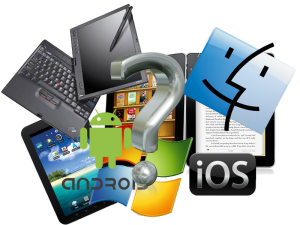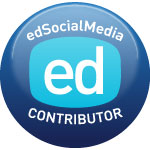NOTE: Originally posted on the Educational Collaborators blog on 1/18/2012 – Update for Ultrabooks below – 1/21/2012.
When you hear people talking about a 1:1 program they could be talking about a lot of different things.
A few years ago what you’d hear people discussing is laptops verse stylus-based tablets (“old school”) and whether do go Mac or PC.
Today’s conversations includes the these things, plus: models of ownership and the BYOD (Bring Your Own Device or BYOT – Technology) model, which includes a whole host of options; the type of device, including the “new school” tablets, the iPad and Android based devices; the addition of Linux, Chrome and iOS in the OS debate.
All of these things are in addition to the conversations around learning goals and the reasons for implementing a 1:1 program. These conversations allow you to plan professional development and the infrastructure pieces that need to be in place to support any of the choices you make.
Let’s briefly look at each of these.
SCHOOL-OWNED VS STUDENT/FAMILY OWNED
Ownership… actually or implied is a key point in any 1:1 program. Deciding this can either be where you start or where you end, but will impact many things.
Who actually owns the device will effect your options for support, procurement, software licensing, your refresh cycle(s), system requirements and what ownership means… just to name a few.
Support is always going to be a major consideration and regardless of who owns the device, it needs to work. If a device doesn’t work during the day, what options are there for that student (or teacher) to continue with their learning (teaching)? You’ll need to be able to troubleshoot problems, have a support plan in place and possibly a fleet of loaners.
What will be purchased? Can you standardize on a single model or will you have multiple version of the “same” device over a set period of time? What happens in the event of a change in platform – laptop to iPad – a year after a family buys the device?
Implied ownership is something to consider. The concept of ownership, that the device is yours and you are responsible for its care and feeding, needs to be engendered in any program.
Can the student or teacher be an administrator on his or her “own” machines? Can they install their own software on the device? Can they put their picture, their music, their games and application on the device? Can I make the device my own… truly own it, regardless of who purchased the device?
DEVICE CHOICE
Today, more than any time before, there is a multitude of devices to choose from for your 1:1 programing.
The classic laptop (full-size, netbook, sub-notebook) has, and continues to be a staple of many programs. With a keyboard, bigger screen and a variety of ways to attach peripheral devices it offers all the power you need to do any type of academic work.
An “old-school” tablet provided everything of a laptop but also gave the user the ability to use a stylus for data input. Long a favorite of science and math teachers for their ease of enter equations and mathematical expressions they can be more costly than a traditional laptop and have had issues with the durability.
However, when you hear tablet people are more likely talking about an iPad or Android-based device.
The “new-school” tablet, the iPad or Android device, is all the rage. Handheld, controlled by your touch, with a built-in on-screen keyboard and smaller and thinner than your average magazine, they can do many of the things a standard laptop or “old-school” tablet. Their ability to use ePubs (eTexts) gives you the potential for all of your textbooks to be on one device.
Others are considering devices such as iPod Touches and smartphones, along with laptops and tablets (old and new school) in their 1:1 programs. As long as the device meets the learning goals and can do the job needed, you can bring it. These programs area characterized as Bring Your Own Device (BYOD or BYOD – Technology) programs.
Given all of these options there is a lot that goes into the choice of device.
THE OS
Your choice of operating systems is no longer just that of the Apple or Windows OS, you now have open-source option like Linux as well as tablet operating systems like iOS and Android.
Each of these operating systems dictate which applications can be run, the type of support and management systems you need to have in place (physical & virtual) as well as guiding the professional development you will offer to faculty in support of the learning goals.
You are going to need help making these decisions, as none should be made lightly. You can form Internal committees, survey your constituency to build consensus, hire consultants (like Educational Collaborators) to help, regardless of what do you’re going to need to have a process in place to guide your decision making.
When dealing with the question of whether to standardize on a single platform we, Montclair Kimberley Academy, engaged in a “Strawman” exercise where we detailed out the options.
We designed a chart with our three choices on the horizontal axis (standardized on a single device, a device that met a minimum set of system requirements or BYOD) and the various consideration and question areas we had on the vertical.
The chart included the broad topics as well the specifics in each area. They areas included: Hardware & Software – hardware, operating system, software; Professional Development, Training and Support – professional development, student training, support, Help Desk (physical & virtual), staffing; Infrastructure – power, backup, wireless, servers.
IN THE END
When considering a 1:1 program at your school there are numerous things to consider. While you can visit school, attend conferences and read all of the available research, not two programs are alike. Don’t be afraid to involve people from within various areas in you school in the process and where needed bring in some help from the outside.
As long as you keep you learning goals in mind and let them drive you decisions you will always end up in the right place.
UPDATE: 1/21/2012 – After the CES 2012 show there was a lot of talk about ultra books. This “new” class of laptop refers to an ultra slim, lower power, performance laptop (not like the under-powered, lower performing netbooks). If you are looking for an example of the “new” device take a look at the Macbook Air, which has been around for a few years.
More on Ultrabooks: http://www.silicon.com/technology/hardware/2012/01/17/ultrabooks-cheat-sheet-39748404/?tag=content;siu-container



